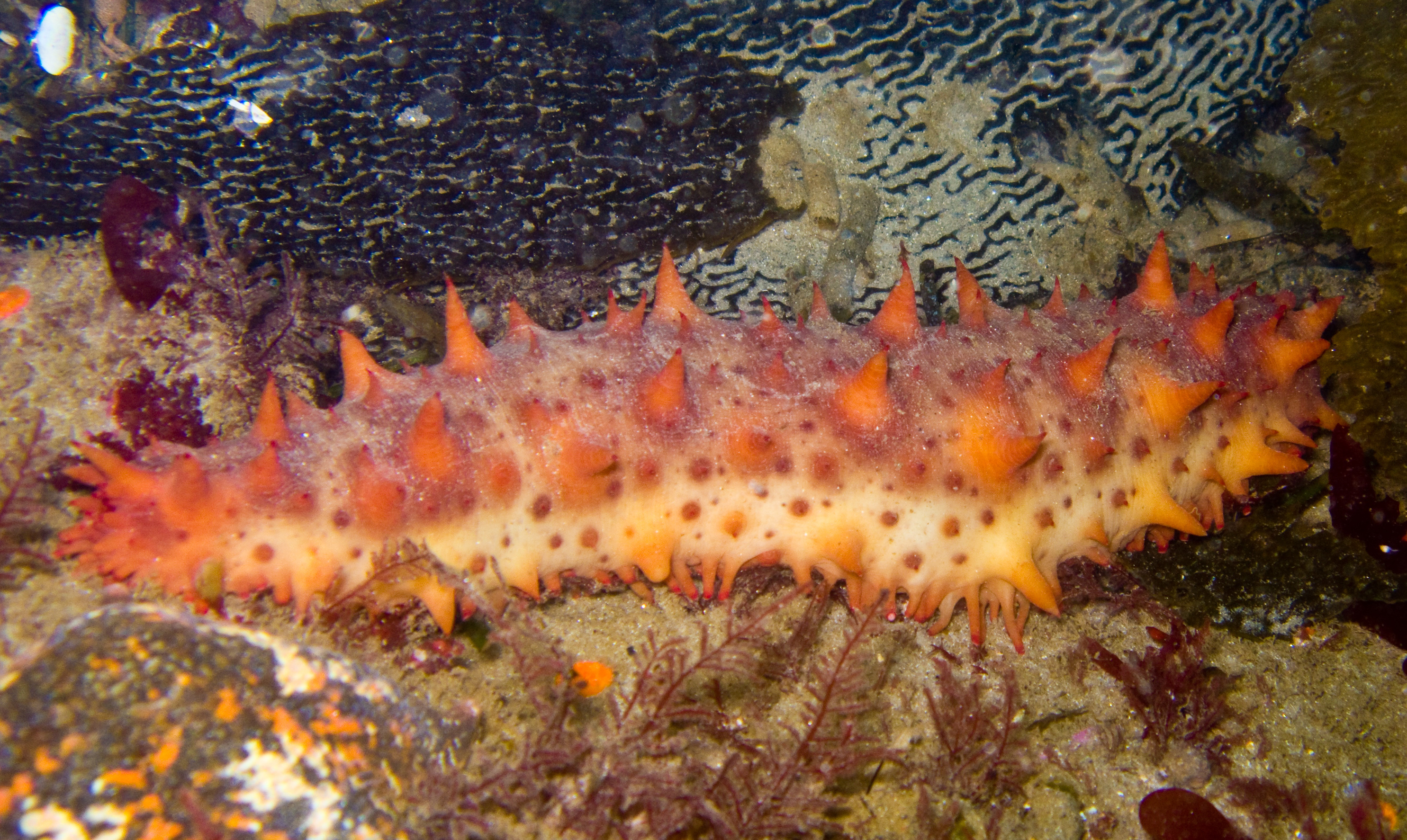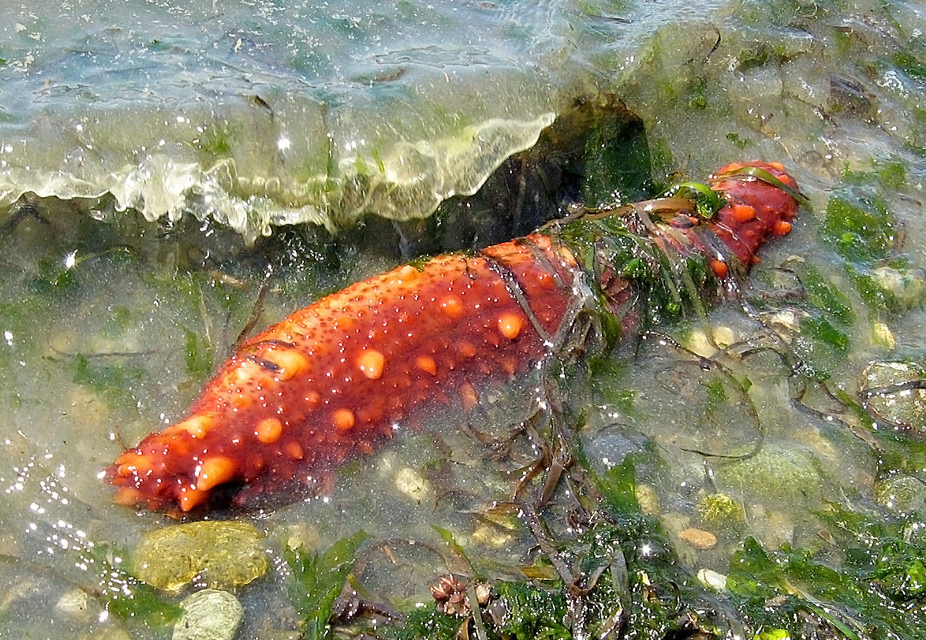Apostichopus californicus
North Coast (Oregon Border to Point Arena)
North Central Coast (South of Point Arena to Half Moon Bay)
Central Coast (South of Half Moon Bay to Point Conception)
Santa Barbara (Point Conception to Point Dume)
South Coast (Point Dume to Mexico border)
Firm fish
Wild caught

The Science

Taxonomic description
- Ranges in color from dark red, brown, and yellow with large, stiff papillae that is lighter in color but is usually tipped red. [3]
- Skeleton is reduced to ossicles in the body wall. [2]
- Is difficult to measure as it contracts, but a maximum length of 50 cm (~2 ft). [3]
- When relaxed, this species is the longest sea cucumber on the West Coast. [4]
Distribution
- Found from Baja California, Mexico to Alaska. [1]
Life history
- Is a broadcast spawner, and spawning is thought to coincide with phytoplankton blooms. [2]
- Becomes reproductively mature between 4 to 8 years old. [2]
- Can live up to 12 years. [1]
Habitat
- Found from low intertidal to depths of 75 meters (249 feet). [4]
- Prefers hard substrates, like rocks and shells, as well as calm water. [1,2]
- Predators include sea stars, various fish, sea otters, and crabs. [2]
- As a deposit feeder, it collects organic matter and microorganisms. [1]
The Fishery
Seasonal availability
- Available year round. [6]
Regulatory and managing authority
- As established by the Marine Life Management Act, the California Fish and Game Commission regulates the fishery, and the California Department of Fish and Wildlife manages this fishery in state waters. [5]
Gear type
- Trawling is only allowed in Southern California. [1]
- Diving for sea cucumber is allowed in Northern California and Southern California. [1]
- Diving is more common than trawling, and usually occurs in conjunction with other dive fisheries, such as the sea urchin. [1]
- Special permits are required to fish for sea cucumber. [5]
Status of the fishery
- Very little is known about the population size, but is thought to be stable. [1,2]
- High natural mortality and slow growth makes this species susceptible to overfishing. [2]
- It is unknown if current fishing rate is sustainable. [2]
- Listed as least concern by IUCN due to its abundance across its entire range. [1]
- The population declined in the 1980s due to lack of regulation, but restrictions allowed for recovery. [1]
Potential ecosystem impacts
- Use of non-selective gear like trawls can damage habitat and result in bycatch, which is mediated in California by restricting trawling in sensitive habitats. [6]
- Channel Islands and Santa Barbara Islands have found a declining sea cucumber population in fished areas. [6]
The Seafood
 Edible portions
Edible portions
- Sea cucumber an be eaten whole, or just the skin or gonads. [2]
Description of meat
- It has little to no taste, but soaks up the flavors it's cooked in. [7]
- The texture is gelatinous. [7]
Culinary uses
- Often boiled, dried, and salted before being exported, as well as frozen or pickled. [2]
- Sold fresh in California. [2]
- Typically, sea cucumber is used in Chinese soups or stews. [2]
- For a recipe for braised sea cucumbers with mushrooms, visit Pacific Sea Cucumbers Harvesters' Association. [10]
Nutritional information
- Rich in healthy levels of Vitamins A, B1, B2, B3 as well as calcium, magnesium, iron, and zinc. [8]
- Anticoagulant, anti-inflammatory, anti-hypertension, antioxidant. [8]
- Low levels of fat but high levels of protein. [8]
- Nutrition Facts for 100g of sea cucumber are found on the table. [9]
Toxicity report
- No known toxins. [8]
Seasonal availability
- Year round. [6]
References
[1] Mercier, A., Hamel, J., Toral-Granda, T., Alvarado, J., Paola Ortiz, E., Benavides, M. 2013. Parastichopus californicus. The IUCN Red List of Threatened Species 2013. Web. http://www.iucnredlist.org/details/180436/0. Accessed 2 May 2017.
[2] Bennet-Rogers, L., Ono, D. 2006. Sea Cucumbers. Pages 1-10. Status of the Fisheries Report. Web. https://nrm.dfg.ca.gov/FileHandler.ashx?DocumentID=34418&inline. Accessed 27 August 2020.
[3] Williams, K., Helmstetler, H., Cowles, D. n.d. Parastichopus californicus. Web. https://inverts.wallawalla.edu/Echinodermata/Class%20Holothuroidea/Paras.... Accessed 27 August 2020.
[4] National Ocean and Atmospheric Administration. California Sea Cucumber, Parastichopis californicus. Web. https://www.afsc.noaa.gov/kodiak/photo/miscuke.htm. Accessed 2 May 2017.
[5] California Department of Fish and Wildlife. 2019. Giant Sea Cucumber, Apostichopus californicus, Enhanced Status Report. Web. https://marinespecies.wildlife.ca.gov/giant-red-sea-cucumber/management/. Accessed 27 August 2020.
[6] Bruckner, A. 2005. The recent status of sea cucumber fisheries in the continental United States of America. Web. https://www.researchgate.net/publication/238745544_The_recent_status_of_.... Accessed 2 May 2017.
[7] Braised Sea Cucumbers with Chinese Vegetables. Web. http://www.food.com/recipe/braised-sea-cucumbers-with-chinese-vegetables.... Accessed 27 May 2017.
[8] Bordbar, S., Anwar, F., Saari, N. 2011. High-Value Components and Bioactives from Sea Cucumbers for Functional Foods- A Review. Web. https://www.ncbi.nlm.nih.gov/pmc/articles/PMC3210605/. Accessed 27 May 2017.
[9] Sea Cucumber. n.d. Nutritionvalue.org. Web. https://www.nutritionvalue.org/Sea_cucumber%2C_yane_%28Alaska_Native%29_.... Accessed 21 September 2017.
[10] Ligia. Pacific Sea Cucumber Harvesters' Association. 2020. Braised Sea Cucumber and Japanese Mushroom with Seasonal Vegetable. Web. https://www.pscha.org/2020/06/16/braised-sea-cucumber-and-japanese-mushr.... Accessed 12 January 2021.
[11] pfly. flickr. 2007. Digital image. Web. https://www.flickr.com/photos/pfly/530310813/. Accessed 12 February 2021.
[12] Stevens, B. and Edward Munk. Alaska Fisheries Science Center. n.d. Digital image. Web. https://archive.fisheries.noaa.gov/afsc/kodiak/photo/miscuke.htm. Accessed 12 February 2021.
[13] Addie. flickr. 2009. dry sea cucumber. Digital image. Web. https://www.flickr.com/photos/addie_oh_addie/3325340770/. Accessed 12 February 2021.
[14] Wang, K. flickr. 2006. Fried sea cucumber. Digital image. Web. https://www.flickr.com/photos/kentwang/132791932. Accessed 12 February 2021.
